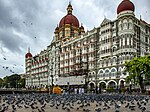Roman Catholic Archdiocese of Bombay

The Roman Catholic Archdiocese of Bombay is a particular church celebrating the Latin Rite of worship, centred in the Bombay (Mumbai) city of the northern Konkan division of Maharashtra, India. The archdiocese has been a Metropolitan see since its elevation, by Pope Leo XIII on 1 September 1886. The seat of the Episcopal See is the Cathedral of the Holy Name (Bombay). It also administers an important minor basilica, the Mount St Mary Church, in Bandra suburb of Bombay. As of 2006, the archdiocese had 277 diocesan priests, 283 religious priests, 383 male religious brothers and 1,530 religious sisters. The archdiocese serves a total of 506,976 Indian Catholics in 121 parishes all across the Greater Bombay Metropolitan Area. The current archbishop is Oswald Gracias, who was appointed on 14 October 2006, by Pope Benedict XVI.
Excerpt from the Wikipedia article Roman Catholic Archdiocese of Bombay (License: CC BY-SA 3.0, Authors, Images).Roman Catholic Archdiocese of Bombay
Convent Street, Mumbai Zone 1 (Mumbai)
Geographical coordinates (GPS) Address Nearby Places Show on map
Geographical coordinates (GPS)
| Latitude | Longitude |
|---|---|
| N 18.923457 ° | E 72.830646 ° |
Address
Convent of Jesus and Mary School
Convent Street
400032 Mumbai, Zone 1 (Mumbai)
Maharashtra, India
Open on Google Maps










